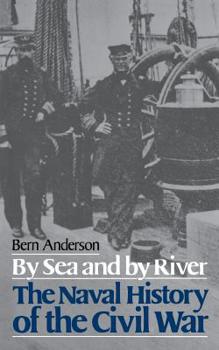By Sea and by River
Select Format
Select Condition 
Book Overview
Less bloody and less known than the land campaigns of the Civil War, the naval battles--and especially the naval blockade of the South--were crucial factors in the outcome of the war. The spectacular... This description may be from another edition of this product.
Format:Paperback
Language:English
ISBN:0306803674
ISBN13:9780306803673
Release Date:August 1989
Publisher:Da Capo Press
Length:342 Pages
Weight:1.00 lbs.
Dimensions:1.0" x 5.4" x 8.2"
Customer Reviews
4 ratings
A Worthy Telling of a Neglected Story
Published by Thriftbooks.com User , 23 years ago
Most popular histories of the Civil War focus almost primarily on land battles, almost to the exclusion of naval aspects of the war. What little reference there is to naval actions tends to be in the nature of trivia, such as the first submarine to sink a ship (C.S.S. R. L. Huntley), the first battle of ironclads in the Western World, the Monitor and Virginia (Merrimack) or songs about the daring Confederate raider, Alabama. As interesting as these anecdotes are, they fail to tell the true story of the important part that naval forces played in the Union conquest of the Confederacy. One seeking an understanding of the significance of the naval forces in the Civil War can find it in By Sea and By River: The Naval History of the Civil War by Bern Anderson. Anderson provides the reader with an excellent overview of naval aspects of the war.The Union war plans called for conquest of the Confederacy by dividing the South and preventing the importation of needed manufactured goods from Europe. Despite attention directed toward the land war. the war was really decided in the West and along the Confederate coastlines. In these two theatres the Union Navy played a crucial role which is often overlooked by leading to the division and economic strangulation of the South. The division of the Confederacy was achieved by two major thrusts, one down the Mississippi River and another through Kentucky, Tennessee and on to Atlanta, culminating in Sherman's March to the Sea. The thrust down the Mississippi involved significant naval action. The economic strangulation of the Confederacy, was achieved by the naval blockade.The U.S. Navy on the western rivers was placed under the command of Captain Andrew H. Foote in September, 1861. In the beginning he was lacking only two requirements of a successful navy, boats and sailors. The shortage of boats was solved by purchases from the Eads Boatworks of St. Louis, founded by engineer James B. Eads, who is primarily remembered for building the Eads Bridge at St. Louis. The shortage of sailors was greater challenge. Although provided with sufficient officers, Foote was left to his own devices to recruit enlisted men. He finally achieved some success in recruiting sailors in the Great Lakes region. With the fleet assembled, Foote was ready to join General Grant in the planning and execution of the thrust down the Mississippi and other western rivers.In November, 1861 Grant began moving against Confederate strongholds in Kentucky, transported by river and supported by naval gunboats. Grant's first great conquest in Southern territory was the conquest of Fort Henry, Tennessee on February 6, 1862. The attack was commenced by four gunboats under the command of Capt. Foote. The plan was for troops under Grant's command to cut off the fort from the rear while it was being bombarded from the river. Muddy roads and high water prevented Grant from cutting off the troops sent f
Excellent reading but primarily written from a Union view.
Published by Thriftbooks.com User , 24 years ago
Admiral Bern is an entertaining writer of history and manages to include a lot of personal anecdotes from letters and diarys. From my knowledge and visits to Civil War forts around the country the author appears to be historically accurate. I would coution that the author seems to be writing primarily from a Union viewpoint. I am sending the book to some of my Navy friends.
One of the Best One Volume Summaries of the Naval Civil War
Published by Thriftbooks.com User , 25 years ago
Bern Anderson's "By Sea and By River" is still perhaps the best one-volume history of the naval side of the Civil War. Strongly recommended for first-time readers on the topic.
A Sea Saga of War and Diplomacy
Published by Thriftbooks.com User , 25 years ago
"By Sea and by River" by Bern Anderson, is an excellent, easy to read story of the Naval History of the Civil War. Without going into detail which would bore the amateur historian, Anderson provides the reader wth an excellent overview of Naval aspects of the war. This book covers the major naval theatres of the war. In the war on the western rivers the Union Navy played a major role in support of the Army attacks along the rivers, such as at Forts Henry and Donelson and Vicksburg. The assault on Island Number Ten in the Mississipi River makes an interesting read. Much attention is directed toward the Blockade, which was, probably, the major naval contribution to the war. All aspects of the blockade are examined. Anderson explains the purpose of the blockade and its role as one of the major methods of strangling the South economically. He details the amphibious operations and how they fit into the blockade. In opposition to the blockade Confederate iron-clad rams had spectacular moments of success but were of little overall significance. The book explains the efforts and limitations of blockade runners and Confederate raiders. The diplomatic entanglements occasioned by the blockade and raiders are presented from all sides.At the conclusion, Anderson sums up the significance of the naval aspect of the war, a significance which many Civil War students will overlook. "By Sea and by River" is an excellent introduction to a very important and, perhaps, decisive, aspect of the Civil War.





